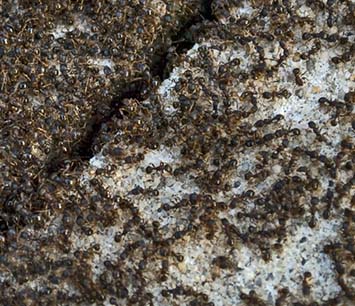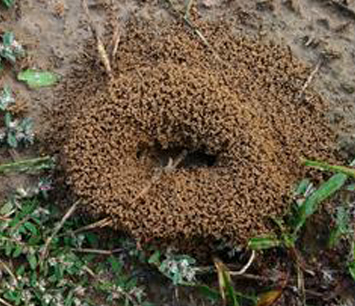
Ant Control & Removal
Ants prefer warm environments which is why, out of the 11,000 species of ant currently recognised globally, only a very small number found in the UK. Fortunately, these ants do not present any significant danger to humans but, when weather and other factors collide, ants can become visible in our homes and we need help to eradicate them.
But first, you need to recognise which ant species and here are the 4 most common…
The common black garden ant is the one most people recognised and are easily spotted in gardens across the UK. However, it is also a common sight creeping up from under the patio and driveway too! You may only spot a handful but in their nest there may be another 4,000 to 7,000 of the quick robust ant species; with the right conditions, this population can double in size. Fond of sugary substances, they also eat the bodies of dead ants within the colony.
No more harmful than their black ant cousins, the yellow meadow ant is often mistaken for red ants, simply because of their yellow/orange colour. Found across fields and meadows – hence its name – these ants are fabulous next builders. Preferring the sanctuary beneath ground, these ants are rarely seen, as they gorge on small insects and mites.
The red wood ant, on the other hand, is found in huge numbers – colonies can number 100,000 or more – and are aggressive, spraying formic acid if they are disturbed. There are sub-species within this type of ant family, but they all act in a similar way. The red ant is the largest of all ants and attack each other nests. Interestingly, they do not kill the worker ants unless they get in the way or attempt to stop them entering…
A small, black stinging ant, Latin name tetramorium caespitum, is commonly found along the south and southern western coasts on England. Nests can be 30,000 or more ants but this would be considered untypically larger as numbers tend to be a third of this. Far more timid that its red ant cousin, it enjoys the food of fallen, rotting logs, boasting the best eyesight of all ant species, as well as being relative peaceful and passive, running away from confrontation…


Know the colony!
Ants live in colonies, in nests in a variety of places, with some species favouring underground and others liking anywhere where there is a good, plentiful food supply where they can remain relatively undisturbed.
Dormant and sleeping during the winter months, ants become increasingly active with the warmth of spring, eventually leaving the nest in search of food. In order for a colony to survive, it needs several key components:
- The Queen Ant is essential, with the survival of the colony virtually gone if this ant is missing. Bigger than male ants and workers, her sole job is to lay eggs, which the worker ants then manage. She enjoys a long life of about 10 to 15 years.
- The worker ants are in the majority on a colony and are all females, but cannot lay eggs. They do all the work around the nest, from looking after the eggs to building extensions. Research shows they live for around 5 years.
- During the summer months, the Queen Ant lays eggs that will not hatch into worker ants, but into male ants. Around the same time, she lays Queen eggs for future use in other colonies. On hatching, the male ants mate with the queen ant… and then they die. The lifespan of a male ant is a few months.
Ants as a problem
In most cases, ants of all species happily exist without them or us encroaching on each other’s space. However, they love sugar and anything sugary, such as nectar. But when the colony is fully populated or even over populated, they can find their way into our homes in search of food.
Needing water to survive, an ant will find a food source, tell the other worker ants and before you know it, there is a long trail of worker ants in procession back and forth to uncovered food, from pet food to anything left out on work tops, as well as the contents of compost bins and rubbish bins too.
Unlike other infestations, ants are relatively harmless. They do not carry disease and neither do they bite or sting (not to the degree we would notice, such as with a wasp sting). But, clearly, having ants crawling along your worktops and food is not something we are happy about!
There are many ways to deal with an ant infestation, some more successful than others; why not discover how quickly we can deal with an ant infestation?
